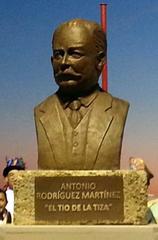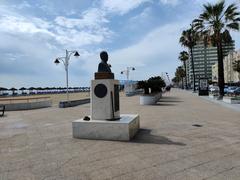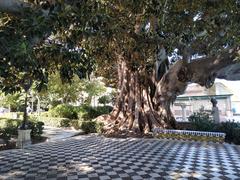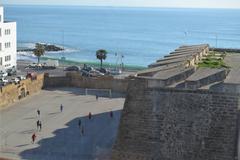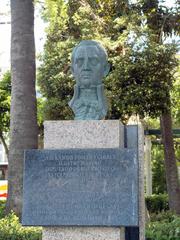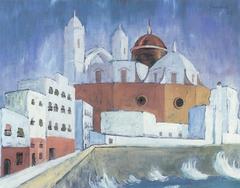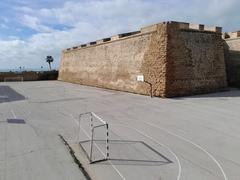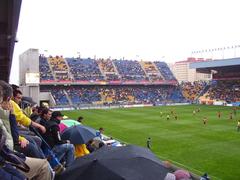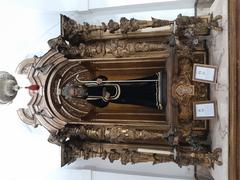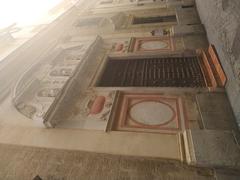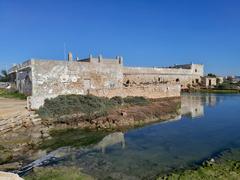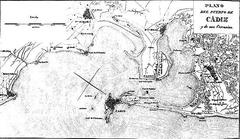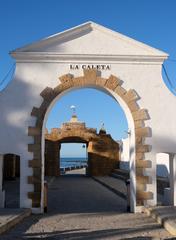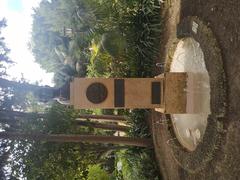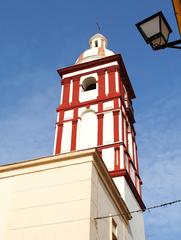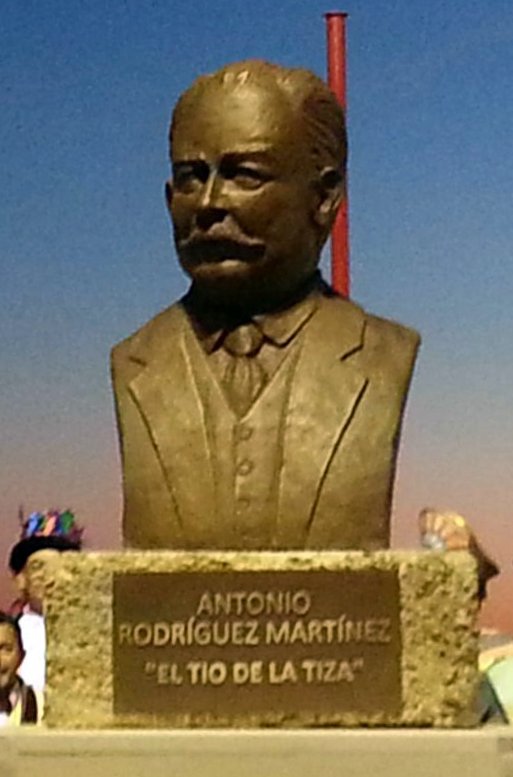
Statue of Antonio Rodríguez Martínez in Cádiz: Visiting Hours, Tickets, and History
Date: 14/06/2025
Introduction
In the heart of Cádiz, Spain—a city famed for its maritime heritage and vibrant Carnival—stands the statue of Antonio Rodríguez Martínez, affectionately known as “El Tío de la Tiza.” This monument pays homage to a seminal figure in Cádiz’s cultural history, whose Carnival tangos and witty social commentary continue to shape the city’s festive spirit. Whether you are a history buff, a lover of music, or a curious traveler, visiting this statue offers a direct connection to the soul of Cádiz.
This detailed guide explores the history of Rodríguez Martínez, the significance of his monument, visiting information, nearby attractions, and practical tips to help you make the most of your visit.
Table of Contents
- Introduction
- Antonio Rodríguez Martínez: Life and Legacy
- Contribution to the Cádiz Carnival
- The Statue: Creation, Location, and Symbolism
- Visiting the Monument: Hours, Accessibility, and Tickets
- Combining Your Visit with Other Cádiz Historical Sites
- Practical Visitor Tips
- FAQ: Visiting the Statue and Surroundings
- Conclusion
- Further Reading and Sources
Antonio Rodríguez Martínez: Life and Legacy
Antonio Rodríguez Martínez (1861–1912), known as “El Tío de la Tiza,” was born in Cádiz and became one of the most influential composers and lyricists of the Cádiz Carnival. His nickname comes from his habit of marking bar tabs with chalk at the local shop “La Lonja.” Martínez began his Carnival career at 25 and is credited with elevating the Carnival tango into an art form. His most famous work, “Los duros antiguos,” remains an anthem of local culture, blending humor and social critique (Carnaval de Cádiz, Learn more).
His legacy is celebrated every year during Carnival, with his compositions performed by new generations of artists. He was posthumously honored with the Antifaz de Oro and named “Hijo Predilecto” (Favored Son) of Cádiz.
Contribution to the Cádiz Carnival
The Cádiz Carnival dates back to the 16th century and is renowned for its sharp wit, musical innovation, and tradition of social critique. Rodríguez Martínez, together with contemporaries like Cañamaque, helped usher in the golden age of Carnival music. His tangos—especially “Los duros antiguos”—are still performed today, their satire and humor resonating with both locals and visitors.
The Carnival itself is a UNESCO-recognized expression of intangible cultural heritage, emphasizing community, creativity, and resilience (Carnaval de Cádiz, CityLife Madrid).
The Statue: Creation, Location, and Symbolism
Creation and Inauguration
The bronze statue of Antonio Rodríguez Martínez was inaugurated on August 29, 2014, to honor his centenary and lasting influence on Cádiz’s Carnival traditions. It was a collaborative effort by the Aula de Cultura del Carnaval de Cádiz and the Ayuntamiento de Cádiz, with the unveiling ceremony featuring Carnival choirs and civic leaders (Statue Details, Cronistas Oficiales).
Artistic Features
The statue, crafted in bronze for durability and expressive detail, depicts Rodríguez Martínez in a thoughtful pose, pen and paper in hand—symbolizing his role as a composer and chronicler of Cádiz’s Carnival. The base is made from local stone and includes a plaque with his name, dates, and an excerpt from “Los duros antiguos.”
Location
There are two commonly referenced locations for the statue, reflecting its cultural prominence:
- Paseo Marítimo, near Calle Brasil: Facing Playa Victoria, this site is linked to the legendary discovery of “los duros antiguos” coins and offers sweeping sea views (Cronistas Oficiales).
- Plaza de la Candelaria: In Cádiz’s historic center, this picturesque square is surrounded by major attractions, including the Cádiz Cathedral and Gran Teatro Falla (Spain.info).
- Note: Some sources also mention a statue in Parque Genovés, a lush city park, but the primary Carnival monument is on the Paseo Marítimo or Plaza de la Candelaria (Visit Andalucia).
Visiting the Monument: Hours, Accessibility, and Tickets
- Visiting Hours: The statue is outdoors and accessible 24/7.
- Tickets: No admission fee is required.
- Accessibility: The sites are wheelchair accessible, with flat, paved walkways and seating nearby.
- Getting There: Easily accessible on foot from Cádiz’s old town, by local bus, or by taxi. Parking is limited in the old town, but public garages are nearby.
Combining Your Visit with Other Cádiz Historical Sites
Cádiz is a compact city brimming with history. Pair your visit to the statue with these nearby attractions:
- Gran Teatro Falla: Center of Carnival performances and the COAC competition (Cadiz.es).
- Cádiz Cathedral: Iconic landmark with panoramic city views.
- Parque Genovés: A botanical garden perfect for a stroll and reflection (Lonely Planet).
- Castillo de Santa Catalina: Historic fortress with bay views.
- Playa de la Caleta: Popular beach for locals and tourists alike.
Guided walking tours often include the statue and offer valuable context on Carnival traditions and Cádiz history (Visit Andalucia, 22places).
Practical Visitor Tips
- Best Times to Visit: Daytime for artistic detail and photography; evenings for atmosphere. The Carnival season (late January to early March) is especially lively.
- Photography: The statue is photogenic, especially in early morning or late afternoon light.
- Amenities: Cafés, tapas bars, and restrooms are nearby in the city center.
- Safety: Cádiz is generally safe, but keep valuables secure during crowded events.
- Accessibility: All main approaches are wheelchair friendly.
- Cultural Etiquette: Respect the monument—do not climb or leave litter.
FAQ: Visiting the Statue and Surroundings
Q: Is there an entrance fee to visit the statue?
A: No, visiting is free.
Q: What are the visiting hours?
A: The statue is accessible at all times.
Q: Are guided tours available?
A: Yes, many walking tours of Cádiz include the statue.
Q: Is the area accessible for wheelchairs?
A: Yes, both locations are fully accessible.
Q: What other attractions are nearby?
A: Gran Teatro Falla, Cádiz Cathedral, Parque Genovés, and more.
Q: Can I take photos?
A: Yes, photography is encouraged.
Conclusion
The statue of Antonio Rodríguez Martínez, “El Tío de la Tiza,” is more than a monument—it’s a living tribute to the wit, music, and communal spirit that define Cádiz. With free access, a central location, and deep ties to the city’s Carnival tradition, it is an essential destination for anyone seeking to understand the heart of Cádiz. Pair your visit with other historic sites, enjoy local cuisine, and immerse yourself in the city’s festive energy.
Further Reading and Sources
- Carnaval de Cádiz (Wikipedia)
- Cronistas Oficiales – Monumento al Tío de la Tiza
- Visit Andalucia – Guide to Cádiz
- CityLife Madrid – Cádiz Carnival Spain
- Official Cádiz Tourism Website
- Lonely Planet – Top Things to Do in Cádiz
- 22places – Cádiz Sehenswürdigkeiten Tipps
Plan your visit and experience the vibrant culture of Cádiz firsthand. Download the Audiala app for guided audio tours, and follow local tourism channels for up-to-date events and insights. Share your photos and stories to help keep the spirit of “El Tío de la Tiza” alive for future generations.
